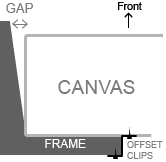 |
| A gilded picture frame, prior to finishing |
Gilding is the process used to apply gold leaf (or sometimes silver leaf) to a surface. This surface can be a three dimensional sculpture, a ceiling moulding, a small object like a door handle, a picture frame, or any number of other items.
In the case of picture frames, this age old decorative style is most commonly used on detailed, ornately carved or sculpted frames, though it can look just as striking on a plain flat or curved face (and is simpler to apply).
There are two main gilding methods: water gilding and oil gilding. Both have many similarities, but a few differences as well that make each more suited to different skill levels and products.
Oil Gilding
 |
| A book of imitation gold leaf |
Oil gilding is the method most suitable for beginners. It gets its name from the oil-based coating applied prior to the gold leaf. Essentially, any object that can be painted can be oil gilded, and items prepared in this way are more durable in outdoor environs.
There are only a few steps involved in oil gilded. Once the object has been primed (technically an optional step, though the base colour will affect the final appearance of the gold), a layer of oil-based "gilding size" is brushed on. The gold leaf is simply laid on top and left to dry.
Water Gilding
Water gilding is the more complicated method of the two. Though the process has changed a little, at its bones it is the same method used by the ancient Egyptians.
The process got its name from the water that is mixed with other mediums during the numerous steps. Water is combined with animal-skin glue and clay powder in various quantities. Water gilded objects can be burnished (rubbed to produce a high shine), unlike oil gilded items.
DIY Gilding
 |
| A great DIY Gilding How-To |
For the crafty among us, gilding is absolutely a project that can be undertaken at home. There are plenty of ways to transform this complicated process into one that can be accomplished in a few hours at the kitchen table.
- Imitation gold leaf is much cheaper than real gold and produces much the same effect.
- In the spirit of saving money, any pieces of leaf that don't adhere in the first layer can be used to cover up missed spots.
- Traditionally, the various coatings are mixed by hand, but today they can be purchased from a good craft store, pre-mixed and ready to use.
- Though not completely authentic, a clear varnish can be used over the dried, gilded frame to make it really last!
For more information on this fun treatment, check out our complete article: Gilding Picture Frames.
 While you're there, why not take a look at our selection of beautiful gold picture frame mouldings and striking classic silver frames. We have options for every budget and decor style.
While you're there, why not take a look at our selection of beautiful gold picture frame mouldings and striking classic silver frames. We have options for every budget and decor style.
We'd love to hear from you! Have you ever gilded a picture frame or used some other method to create a stunning gold or silver decor piece? Tell us about your experience in the comments section!










